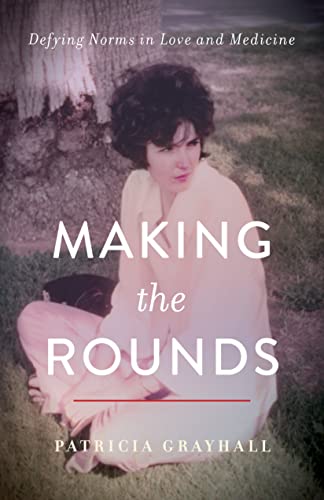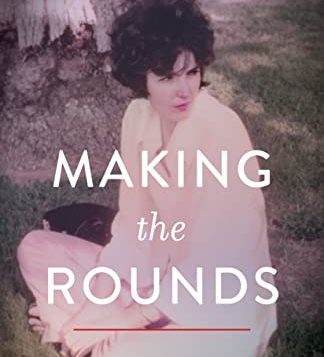 MAKING THE ROUNDS
MAKING THE ROUNDS
Defying Norms in Love and Medicine
by Patricia Grayhall
She Writes Press. 344 pages, $17.95
The author was born in Phoenix in 1950 and became aware of her attraction to girls as early as grade school. With a mother who insisted on typically feminine dress and behavior and a father frequently hospitalized for depression, Patricia worried that being a lesbian might point to mental health issues for her, too. By high school she was six feet tall, “uncoordinated, bespectacled and studious.” She spent hours in the local library, where the books she could find about homosexuality said it was a mental illness caused by difficulties in childhood, that treatment was often unsuccessful, and that homosexuals were doomed to unhappy lives.
Grayhall’s research turned up a phone number for Daughters of Bilitis, the first U.S. lesbian rights organization, and she requested a copy of their publication The Ladder (1956–’72). Its short stories and poetry saluted lesbian love, but her mother’s appalled reaction to the magazine dampened her hopes. She resolved to prove she “wasn’t lesbian” by dating men, but when one such affair ended in a frightening trip to Nogales, Mexico, for an abortion, the nineteen-year-old stopped “pretending to be straight.”
Making the Rounds takes off from there, using material from Grayhall’s journals, letters, and interviews to chronicle her experience from medical school through residency, fellowship, and boards. The memoir interweaves details from the writer’s medical training with episodes from her struggle to find a soulmate, but the stories are considered separately here, for clarity.
Grayhall’s professional story is all about pluck. Drawn to the path taken by her grandfather, a well-liked general practitioner, she applies to medical school while a junior at Arizona State. Astonishingly, the University of Utah accepts her without a college degree, and in the fall of 1971 she moves to Salt Lake City. One of five women among 100 students, she rooms with an also closeted gay medical student, David. The arrangement wards off inquiries about sexual identity and relieves the author’s fear of being “ostracized for being a lesbian.” The amiable duo would share quarters for the next decade.
Medical school is predictably demanding, but Grayhall does well. Her residency at Boston University Hospital proves harsher. As the only woman intern, she’s routinely disregarded or unfairly singled out for criticism. Angry and despondent, she focuses on a broader concern, the medical center’s practice of testing and treating patients regardless of the pain involved, even when there is no hope of recovery. When she writes a letter to the Harvard School of Public Health expressing these worries, she’s offered a research fellowship in occupational and environmental health. Three years later she finishes the interrupted residency, passes boards in two fields, and accepts a position with the recently created Occupational Safety and Health Administration (OSHA) in Washington, D.C.
By 1980, Grayhall’s medical career is well launched, but her tougher parallel quest for lasting love has come up empty. That search had begun the summer before medical school, when the author visited San Francisco and its iconic lesbian bar, Maud’s, where she met Cecilia, an older Asian woman and literature student. “I towered over her,” says the author, who found herself “overwhelmed by the ecstatic release” in their lovemaking. But when she couldn’t meet Cecilia’s request to stop dating others, things cooled.
During her first year of medical school, while on rotation at New England Medical Center, Grayhall hangs out at The Saints, a popular lesbian bar in Boston, where she spots Cass, a mother of two who’s separated from her husband and lives in New Hampshire. Captivated, Grayhall rides a bus to Peterborough on weekends, but once back in Utah on other rotations she falls for Dee, head of a hospital pulmonary therapy department. Short, self-confident, and “sharply dressed,” Dee garners approval from Grayhall’s mother at medical school graduation in 1975, but her relationship with the writer founders.
When Grayhall returns to Boston as an M.D. for her medical residency and then a fellowship, things get complicated. Cass is sometimes back in the picture and the writer is also sleeping with English teacher Maryann, who has accepted her invitation to move in with her and David. Yet when the striking, Oxford-trained biologist Gillian shows up in epidemiology class, Grayhall begins to ignore Maryann. Writer and biologist co-teach a Harvard course on “Women and Cancer,” but they are only occasional lovers and break up when Gillian’s ambivalence about being in any intimate relationship, much less a lesbian one, becomes clear.
Enter Dani, a photographer who’s as tall as Grayhall, and as forthright. They meet at a Gay Women Professionals gathering in Boston and become ardent lovers. In spring 1979 the author gives Dani a ring, and the pair travel to Isla Mujeres (“Women Island”) in the Caribbean. The lovestruck M.D. has come full circle and wants an exclusive relationship, but Dani views monogamy as confining, and balks. Eventually a shattered Grayhall calls it quits and leaves for the OSHA job.
If her romantic quest has come up empty, it has still delivered powerful insights. For one, Grayhall has come to understand how feminism falls short of helping lesbian couples. “My exposure to the women’s movement … had taught me female eroticism was cause for celebration, but it provided few models of sustaining relationship beyond desire. I didn’t even know where to begin,” she says. “In Boston in the seventies, while the free-wheeling sexual revolution was conducive to having affairs, it wasn’t conducive to monogamous couplings among lesbians, except for a lucky few.”
Making the Rounds is alive with passion and tumult, a discovery narrative in which the writer comes to recognize herself as capable of love. More reflection on the transformation might have been nice. But then again, the journey was hectic!
Rosemary Booth is a writer and photographer living in Cambridge, Massachusetts.






